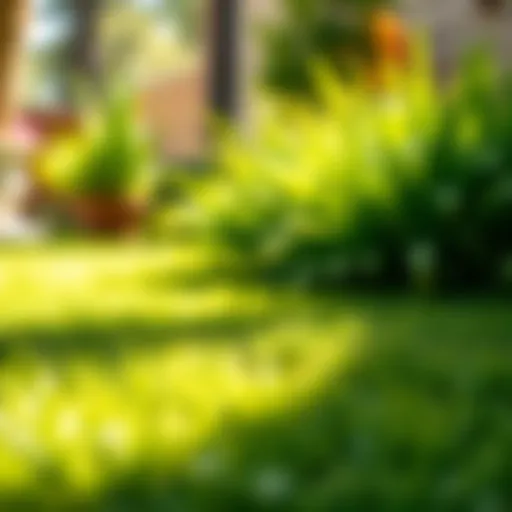Top Strategies to Remove Squirrels from Your Shed
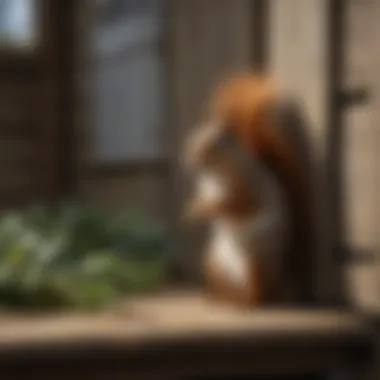

Intro
Squirrels can be charming little creatures, but when they invade your shed, they transform into unwelcome pests. Homeowners often face the challenge of dealing with these persistent animals, which can cause significant damage. Understanding how to effectively remove squirrels from your shed requires a blend of knowledge, strategy, and respect for wildlife.
This article explores various methods to help you address this issue comprehensively. We will look at different strategies, including physical barriers, natural repellents, and humane trapping options. Each method will be dissected to provide the best practices, ensuring you can protect your shed without harming the animals. With these tools at your disposal, you will be better equipped to keep your shed squirrel-free.
Understanding the Squirrel Problem
Dealing with squirrels in your shed can be more than just a nuisance; it presents a unique set of challenges that necessitate a thoughtful approach. Understanding the squirrel problem is essential for effectively managing or eliminating their presence. Firstly, squirrels may not only occupy the shed but can also cause substantial damage to stored items, wiring, and insulation. This can lead to potentially costly repairs. Furthermore, the presence of squirrels can signal an underlying issue with how your shed is maintained and secured.
Knowing the specifics about the types of squirrels that might invade your space is vital. Some species are more prone to invade human dwellings than others. This knowledge informs your strategy, as different squirrels may require different methods for removal.
The Importance of Identifying the Species
Identifying the species of squirrels present in or around your shed is crucial. For instance, the eastern gray squirrel and the fox squirrel exhibit distinct behaviors that affect how they exploit their surroundings. Understanding these differences can enhance your chances of successful deterrent methods. Moreover, some species may be protected by law, meaning that removal methods need to be compliant with local regulations. Thus, recognizing the type of squirrel involved not only aids in effective management but also in abiding by legal frameworks surrounding wildlife.
Common Signs of Squirrel Infestation
Several indicators can alert you to a squirrel infestation. One of the first signs is noticeable gnawing marks on wood or stored items within the shed. Squirrels have constantly growing teeth, which means they need to gnaw to keep them in check. Look for droppings, which are usually small and resemble dark, pellet-like traces. Additionally, you might hear scratching or scurrying noises, particularly during dawn and dusk when squirrels are most active.
If you notice nesting materials like shredded paper, leaves, or fabric, these can also signal an active infestation. Keeping vigilant can allow you to address the problem sooner rather than later.
Identifying the problems associated with squirrels can prevent bigger issues down the road.
Assessing Your Shed's Vulnerabilities
Assessing the vulnerabilities of your shed is a crucial step in safeguarding it against squirrel infestations. By thoroughly evaluating different aspects of your shed's structure, you can identify where these animals might gain access. This process not only helps in eliminating squirrels but also aids in preventing future incursions. Knowing your shed's weaknesses enables you to implement targeted strategies for exclusion and defense.
Inspecting Entry Points
To start, inspect all potential entry points where squirrels might enter your shed. This includes gaps in siding, openings around windows and doors, and any holes in the roof. Squirrels are agile and can squeeze through surprisingly small spaces. A hole just the size of a quarter can provide enough access for a squirrel. When examining these areas, look for signs of gnawing or scratching, as this can indicate where squirrels have tried to enter.
As you carry out this inspection, make a checklist of areas that need repairs or sealing. Pay special attention to:
- Ventilation holes: Squirrels can easily enter through these if not properly guarded.
- Drain spouts and gutters: These are often overlooked but can offer access points.
- Foundation cracks: Small gaps at the base of your shed can be inviting.
Once you have identified potential weaknesses, consider methods to seal these entry points. Using materials such as steel mesh or hardware cloth can act as a deterrent against their persistent gnawing.
Understanding Shelter Needs of Squirrels
Understanding the shelter needs of squirrels provides essential insights into why they may choose to invade your shed. Squirrels are naturally drawn to places that offer warmth, safety, and proximity to food. Your shed, if it contains tools, garden supplies, or even birdseed, can appear as an ideal habitat.
Squirrels are known to prefer certain conditions, including:
- Dark, secluded areas: They seek spots that are less disturbed, providing them a sense of security.
- Nesting materials: If items such as insulation or cloth are present in your shed, they can be attractive for nest-building.
- Food sources: Any stored seeds or scraps can attract them quickly.
Understanding these needs will help you to implement more effective preventive measures as you secure your shed. By acknowledging what attracts squirrels, you can minimize these incentives, forcing them to seek shelter elsewhere.
Preventive Measures to Deter Squirrels
Preventive measures are essential when tackling the issue of squirrels invading your shed. Squirrels are opportunistic creatures, drawn to easily accessible food and shelter. By taking proactive steps, you can significantly minimize the risk of these pests becoming a nuisance. Effective prevention not only saves you time and resources in dealing with infestations but also protects your belongings and the structural integrity of your shed. Therefore, understanding and implementing preventive strategies is crucial for a homeowner.
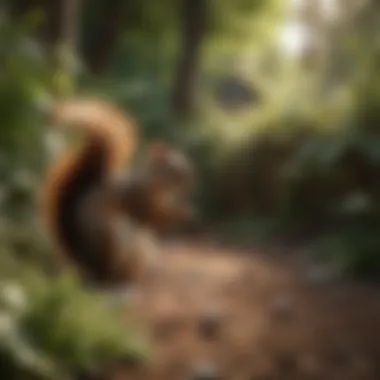

Securing Entry Points
A primary step in preventing squirrels is to secure all potential entry points to your shed. Squirrels are agile climbers and can squeeze through surprisingly small gaps. Examine the exterior carefully. Pay attention to areas such as:
- Gaps around windows and doors
- Open vents and holes in the siding
- Cracks in walls, especially near the foundation
Use materials like steel mesh or hardware cloth to close these openings. Be sure to check regularly, as squirrels can be persistent and might find new ways to enter your shed. Sealing entry points can greatly deter squirrels from making your shed their home.
Utilizing Physical Barriers
In addition to securing entry points, incorporating physical barriers can be highly effective. Installing metal flashing or a sturdy screen over potential access areas makes it difficult for squirrels to enter. These barriers should be well-installed and cover any gaps that might exist. Moreover, consider:
- Elevating shed structures slightly off the ground
- Using sliding doors or hatches that can be locked
- Adding a roof overhang to reduce access from trees
These strategies create a much less inviting environment for squirrels, decreasing the likelihood of them attempting to invade your shed.
Organizing Shed Contents
Lastly, organizing the contents of your shed plays a pivotal role in deterring squirrel activity. Clutter can attract squirrels by providing them with hidden spaces for nesting. A clean and organized shed offers fewer opportunities for squirrels to settle in. To maintain an orderly space, consider:
- Storing food items in airtight containers
- Keeping tools and supplies off the floor, ideally on shelves
- Regularly disposing of debris and old materials
By minimizing clutter, you make your shed significantly less appealing to squirrels. Maintaining cleanliness can deter not just squirrels but other pests as well.
"Preventative measures are not a one-time task; they require ongoing attention and routine checks."
Implementing Deterrents
Implementing deterrents is a crucial step in addressing the issue of squirrels invading your shed. These methods are effective for several reasons. First, they serve as proactive measures, reducing the likelihood of squirrels entering your space. Second, deterrents can minimize potential damage caused by these animals, as well as the risk of diseases they might carry. By focusing on specific elements such as natural repellents, chemical options, and electronic devices, homeowners can tailor their strategies to fit their situation.
Natural Repellents
Natural repellents offer an environmentally-friendly option to deter squirrels. These substances typically rely on strong scents that squirrels find unpleasant. Common natural repellents include peppermint oil, cayenne pepper, and vinegar. They can be applied in various ways:
- Soaking Rags: Dip rags in a solution made from essential oils or vinegar and hang them in areas frequented by squirrels.
- Spraying: Create a spray using water mixed with cayenne pepper or essential oils and apply it around entry points and the shed's perimeter.
- Planting: Certain plants, such as oregano and sage, naturally repel squirrels. Planting these near your shed can act as a deterrent.
These methods are simple to implement and safe for both pets and children.
Chemical Repellents: A Cautionary Approach
Chemical repellents can be effective but come with significant considerations. Many products on the market are specifically formulated to deter rodents. Examples include squirrel repellents containing ingredients like naphthalene or thiram. However, caution is needed when using these chemicals:
- Toxicity: Certain chemicals may pose risks to other wildlife or pets. Always read labels carefully and confirm that the product is designed for squirrel control.
- Environmental Impact: Some chemical solutions can have adverse effects on local ecosystems. Use them sparingly and consider alternatives.
- Application Techniques: Apply these chemicals according to instructions to ensure effectiveness while minimizing exposure to unintended targets.
Chemical deterrents can provide strong results when used judiciously and responsibly.
Electronic Deterrent Devices
Electronic deterrent devices represent a modern approach to squirrel control. These devices typically use sounds, lights, or even motion to scare squirrels away. The main types of electronic deterrents include:
- Ultrasonic Repellers: These devices emit high-frequency sounds that are inaudible to humans but irritating to rodents. Placement near entry points is essential for maximum efficacy.
- Motion-Activated Sprinklers: These systems detect movement and release a burst of water to startle intruding squirrels. This method is quite effective and serves dual purposes, like watering plants.
- LED Motion Lights: Bright lights can deter squirrels during night hours, disrupting their activity.
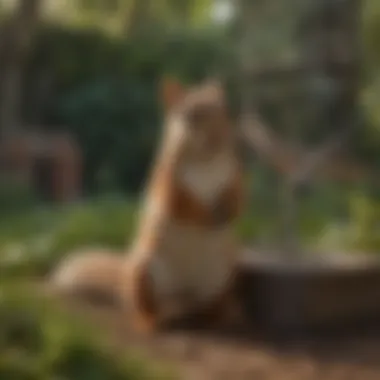

When using electronic devices, it is crucial to ensure their placement and settings are effective. Regular maintenance checks will keep them operational and ensure they perform well over time.
Humane Trapping Methods
Humane trapping methods play a crucial role in addressing squirrel infestations in your shed. These methods prioritize the well-being of the animal while providing a solution for homeowners facing such issues. Using humane traps can prevent harm to the squirrels and align with ethical considerations regarding wildlife treatment. Furthermore, these strategies allow for removal without significant disruption to the local ecosystem.
Selecting the Right Trap
Choosing the right trap is essential for effective humane trapping. There are various options on the market, such as live traps designed specifically for squirrels. When selecting a trap, consider the following factors:
- Size: Ensure that the trap is properly sized for squirrels. A too-large trap may not effectively capture them.
- Material: Traps made of sturdy metal are durable and less likely to be damaged by animals.
- Design: Look for traps with secure doors that close promptly when the squirrel enters.
Additionally, consider traps that are easy to set and check frequently. Getting familiar with the specific type of squirrel can help ensure that you select the most appropriate design.
Baiting Techniques for Success
Once you have selected a suitable trap, the next step is baiting it effectively. Good bait will attract the squirrels and increase your chances of a successful catch. Common baits that have proven effective include:
- Nuts: Squirrels are particularly attracted to foods like peanuts and walnuts.
- Fruits: Apples and berries can also serve as enticing bait.
- Vegetables: Corn may appeal to squirrels and is often used.
Place the bait at the end of the trap to encourage the squirrel to enter fully. Positioning it near the back ensures that the animal's weight triggers the closing mechanism. You may want to try different bait options to see which works best in your case.
Best Practices for Release
After successfully trapping the squirrel, it is important to follow best practices for release to ensure the animal's safety and health. Here are some key points to remember:
- Choose a Suitable Location: Release squirrels at least 5 miles away from your home in a natural setting, away from urban areas. This helps prevent them from returning.
- Timing: Aim for a release during the early morning or late afternoon, when activity levels are typically lower, reducing stress on the animal.
- Handle with Care: If you need to move the trap, do so gently. Avoid shaking or banging the trap.
It is essential to check your local regulations on wildlife release to comply with any legal requirements concerning native species.
By following these humane trapping methods, you can effectively manage squirrel populations in your shed while adhering to ethical considerations. These practices not only contribute to humane treatment but also promote responsible interactions with our wildlife.
What to Do After Removal
After successfully removing squirrels from your shed, it is crucial to assess the situation to avoid future infestations. The aftermath of a squirrel removal involves cleaning, sanitizing, and reinforcing preventive measures. These steps not only protect your belongings but also help restore your shed to a safe environment.
Cleaning and Sanitizing the Shed
Cleaning and sanitizing your shed is essential after the removal of squirrels. Squirrels can leave behind droppings, urine, and nesting materials that pose health risks. Excrement may carry diseases transmissible to humans or other pets. Therefore, it is important to approach this task with care.
- Wear Protective Gear: Use gloves, dust masks, and goggles to protect yourself while cleaning. This gear helps prevent the inhalation of harmful particles.
- Remove Nesting Materials: Gather any nesting materials such as leaves or twigs. Dispose of them in sealed bags to ensure that no remnants are left in your shed.
- Disinfect Surfaces: Use a mixture of bleach and water or a commercial disinfectant to wipe down all surfaces inside the shed. Pay special attention to areas where squirrels have been active. This cleaning reduces health risks.
- Ventilation: Ensure proper ventilation during and after cleaning. Open doors and windows to allow fresh air to circulate, helping to eliminate lingering odors.
Proper sanitation after a pest removal is key. It ensures that not only are the visible signs of the pest addressed but also the potential health risks.
By following these steps, the shed will be ready for future use without the fear of contamination.
Reinforcing Preventive Measures
Once your shed is clean, the next step focuses on reinforcing preventive measures. This phase is crucial to deter any future squirrel invasions and to maintain a serene environment.
- Inspect and Seal Entry Points: Conduct a thorough inspection of the shed's exterior. Look for cracks, holes, or other entry points. Use hardware cloth or caulk to seal these gaps. Focus on areas around vents or where pipes enter the building.
- Store Food Properly: If your shed contains birdseed or pet food, consider transferring these items into metal or sealed plastic containers. This step prevents squirrels from being attracted by food sources.
- Keep the Area Clean: Regularly check the vicinity of your shed for any food scraps or debris. Keeping the area clean will reduce the likelihood of attracting squirrels back.
- Use Barriers: If squirrels are persistent in your garden, contemplate installing fences or hedges around the shed. These barriers can keep squirrels at bay.
- Monitor Regularly: Schedule regular checks, especially during the autumn months when squirrels search for warm nesting spots. Being vigilant can help catch any issues early on.
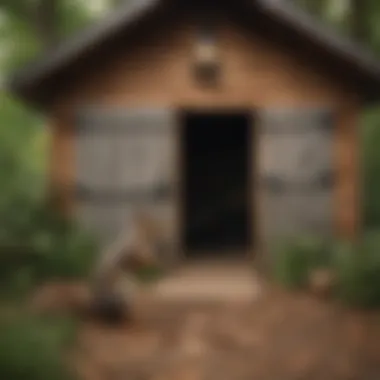

It is clear that these post-removal steps are essential in achieving a long-term solution to your squirrel problem. By committing to a clean and secure environment, you significantly limit the likelihood of a recurrence.
Legal and Ethical Considerations
Understanding the legal and ethical considerations surrounding the removal of squirrels is vital for anyone dealing with this issue. Laws vary by region and can impact the methods used for removing squirrels from your shed. Ignoring these regulations can lead to fines or legal consequences, so it is essential to be informed. Moreover, ethical treatment of wildlife reflects a broader responsibility to respect nature while resolving conflicts with animals.
Understanding Local Wildlife Laws
Local wildlife laws govern the treatment of animals, including squirrels. These laws are designed to protect both the species and their habitats. Many regions prohibit the killing of certain wildlife, while others may impose guidelines on the trapping and relocation of animals. This means that homeowners need to check local regulations before engaging in any removal efforts. For example, in some areas, you may be required to use specific types of traps or to take captured squirrels to designated locations for release.
Failing to comply with these laws not only jeopardizes your efforts but can also lead to negative consequences. Therefore, it is prudent to reach out to local wildlife agencies or consult their websites for guidance on the legal aspects of squirrel removal. Resources such as Wikipedia and Britannica can provide insights into wildlife laws pertinent to your area.
Ethical Treatment of Wildlife
Ethically treating wildlife involves considering the well-being of the animals involved. Squirrels, like all creatures, play a role in the ecosystem. It is essential to balance the need for removal with compassion for the animal. Humane trapping methods, such as those discussed previously, reduce suffering and allow for safe relocation. The philosophy of treating wildlife ethically should extend to all interactions, whether in removal or observation.
Homeowners can adopt respectful practices that prioritize the welfare of the animal by using non-lethal deterrents and humane traps. Additionally, reporting sightings of squirrels in need of assistance can help local wildlife rescue organizations intervene effectively.
"Respecting wildlife not only preserves the balance of nature but also allows for more harmonious coexistence."
To conclude, understanding the legal and ethical considerations in squirrel removal is fundamental. It ensures compliance with regulations and reflects a commitment to humane treatment of the animals we share our environments with. Thus, any strategy you implement should be coupled with a level of respect for these creatures.
When to Seek Professional Help
Determining when to involve a professional in squirrel removal is significant. It not only ensures effectiveness but also focuses on safety for both the homeowner and the wildlife involved. The methods discussed earlier may be efficient for mild infestations. However, more serious cases may require expertise that exceeds basic homeowner capabilities.
Squirrels are adaptive creatures that can pose challenges when they invade spaces like sheds. If individuals see ongoing activity, hear noises frequently, or notice extensive damage, it is time to consult a professional. Their experience can help effectively identify the species involved, suggest tailored solutions, and ensure compliance with local wildlife regulations. Furthermore, professionals often have access to advanced trapping and removal techniques that individuals may not be aware of or able to implement safely.
"Professional help can turn the tide in complicated situations, providing peace of mind and resolution that DIY efforts may fail to achieve."
Identifying Complex Cases
Understanding complex cases begins with recognizing the signs that indicate a more severe problem. Random nibbling on objects or persistent sounds in the shed may not warrant a call to an expert. However, certain indicators suggest a greater issue:
- Increase in Damage: Continuous destruction of materials in or around the shed.
- Repeated Sightings: Frequent observations of squirrels in the same area, especially if young ones are present.
- Infrequent Access: If squirrels appear to adapt their behavior to evade DIY measures, their intelligence could make them more challenging to remove.
A detailed inspection can highlight these complexities, making it evident when professional assistance becomes warranted. Professionals can assess whether there is a larger population at hand or other animal interactions complicating the issue.
Choosing a Pest Control Service
Selecting the right pest control service involves several considerations to ensure appropriate treatment. Here are key factors to evaluate:
- Experience and Expertise: Look for companies with a proven track record in wildlife management, particularly with squirrels.
- Local Knowledge: Services familiar with the area will understand local laws and wildlife habits, ensuring they remain compliant and effective.
- Humane Practices: Ensure the chosen service values ethical treatment of wildlife and employs humane removal techniques.
- Comprehensive Services: Opt for companies offering follow-up services, consultations, and preventive measure recommendations to prevent re-infestation.
Ultimately, engaging a quality pest control service can save time and effort, helping to provide lasting solutions to squirrel-related challenges.
End
The importance of taking effective measures cannot be overstated. First, investing time in assessing your shed's vulnerabilities helps you identify entry points. By securing these openings, you reduce the likelihood of future infestations. Additionally, employing deterring techniques, such as natural repellents or physical barriers, can be extremely effective in keeping squirrels at bay.
Furthermore, after successfully removing any existing squirrels, the importance of cleaning and sanitizing your shed is paramount. Squirrels can leave behind droppings and nesting materials, which pose health risks. A thorough cleaning not only ensures a safe environment but also helps you maintain your space for its intended purpose.
There are also legal and ethical considerations to keep in mind. Understanding local wildlife laws is crucial for avoiding repercussions while ensuring humane treatment of any trapped animals. It is essential to approach the problem with sensitivity, balancing your needs with a commitment to the environment.
Finally, there will be situations where professional help is necessary. Recognizing complex cases early on can save time and mitigate further complications. By choosing the right pest control service, you can navigate these challenges more effectively.
By considering these various elements, the approaches outlined in this article aim to equip you with the tools needed not only to address squirrel issues but also to foster a safe sanctuary for your projects and belongings. Squirrels are a part of the ecosystem, and understanding how to cohabitate with them—while maintaining the integrity of your shed—is crucial. Mastering these strategies will enhance your living space and protect your property effectively.







